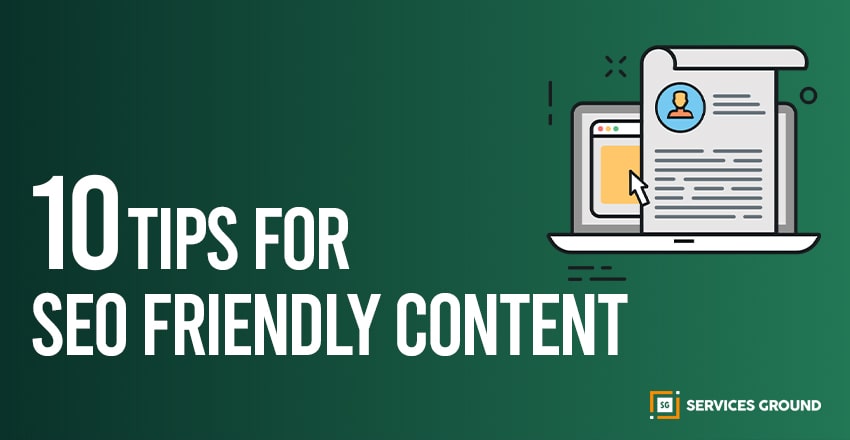It is no secret that to rank on Google, awesome and creative content is the Key! And for your content to rank, you also need legit SEO on your website.
It may sound strange to you but SEO beings even before you start writing a single word. That is because you need to write content that your audience cares about. You need to figure out what your targeted audience is searching for and what they are interested in.
That being said, today we will talk about 10 Tips For SEO Friendly Content:
- Thinking before writing
Before starting all this, think peacefully about what you are going to convey. What do you want to tell your readers or which central question do you want to answer? What’s the purpose of your article? And what do you want your readers to do at the end of the page? Write down the answers to these questions before you begin.
2. Blog post structure
To write a readable and SEO-friendly blog post, you need to create a clear structure. This means that every post should have:
- some sort of introduction (in which you introduce your topic);
- a body (in which the main message is written);
- a conclusion (in which you summarize the main ideas or draw a conclusion).
In a few sentences, write down what you want to say in all three sections. You’ve now created the summary of your post, this will help you create a structured and readable blog post. Now the real writing can begin.
3. Usage of paragraphs
Using paragraphs and using them well is two different things. Don’t start each new sentence on a new line, just because it looks nice.
Also, try not to make them too lengthy, as each paragraph should have its own idea or subject. Ask yourself what the main idea of each paragraph is. You should be able to summarize that main idea in one sentence.
4. Using headings
Headings structure the whole text, so use them. They’re not just important for readability, but for SEO as well. Headings help Google grasp the main topics of a long post and can therefore benefit your rankings. If you want people to find their way through your articles, you should use subheadings to lead them, help them scan your page, and clarify the structure of your articles.
5. Transition words
Transition words help people scan through your text and understand the relationship between sentences and paragraphs. For example, let’s say that there are three reasons for people to buy your product. You should use signal words like: ‘first of all’; ‘secondly’ and ‘finally’.
Also, words like ‘however’, ‘similarly’ and ‘for example’ give a clear signal to your readers. Readers will instantly get that a conclusion will follow after words like ‘to sum up’ or ‘in short’. This helps a lot in improving your SEO of the article.
6. Optimize the length of your article
Make sure your blog posts have a minimum of 300 words but keep the length of your article balanced. Google likes long articles, however, if your article is too long it can scare users away. I would advise to only write long articles when you know you’re a skilled writer. It’s asking a lot of your visitors to read your entire post when it’s lengthy. Check out this article if you’re not quite sure how long a blog post should be.
7. Linking to previous content/articles
If you’ve already written content on the same topic as your current post, don’t forget to link to and from these posts. It will make your new blog post, and the existing posts, stronger because you’re showing authority on the subject.
As well as that, your link structure is also important for your rankings in Google. And let’s not forget that linking to other content about a subject is great for your readers, as they may be interested in reading these related posts too. It helps them navigate your site.
8. Letting other people read your posts
Before publishing your post, make sure to let someone else read it first. Ask them whether they understand the main concept of your post and invite them to correct any typos and grammatical errors. This can help you by providing an objective view of the readability and attractiveness of your text.
If you have someone in your team who happens to be an expert on the topic you’re writing about, make sure to run your post past them. That way they can check whether you’re covering everything you need to and give suggestions to make your post even better.
9. Daily Content Creation
Regularly adding new blog posts to your website tells Google that your website is alive. This is important because if your site isn’t active, Google will crawl it less often and this might negatively affect your rankings. But don’t just post for the sake of posting. Make sure that everything you post is high-quality content: informative, well-written articles that entertain readers and fit their search intent.
10. Using Yoast SEO Plugin
Yoast SEO plugin helps you write readable and SEO friendly content. Start by choosing the most important search term you want people to find this particular page for. This is your focus keyphrase and after you fill this in our plugin runs all kinds of checks to see whether your post is optimized or still needs improving.
These are the 10 Tips that will help you with SEO Friendly Content. If you want more of these articles, make sure to subscribe to our Newsletter.








